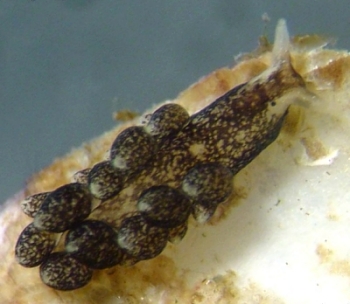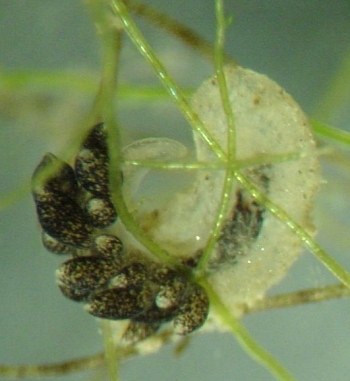

Calliopaea bellula
Orbigny, 1837
Order: SACOGLOSSA
Family: Limapontiidae
DISTRIBUTION
Recorded in northeastern Atlantic from Norway down to the Mediterranean and Black Sea.
PHOTO
Locality: Audenge, Bassin d'Arcachon, 1 m, France, Atlantic Ocean, 09 October 2006, mud with algae. Length: 5mm. Lower photo showing animal feeding on eggs of Haminoea. Photographer: Marina Poddubetskaia.
Note added 26 March 2009: This species was previously known on the Forum as Stiliger bellulus.
The animal is translucent greenish or grey with a heavy mottling of black over the body and cerata. The rhinophores, sides of the head and tips of the cerata lack black pigmentation. The cerata are relatively short, but very inflated, and arranged in about 6 rows on each side of the body. The rows do not start until about half way down the body, leaving the anterior half of the body clear. It grows to about 10 mm in length.
As a sacoglossan, we might expect to find this species feeding on algae, but Bernard Picton's message below suggests that it feeds on Philine eggs (and possibly other opisthobranch eggs). Since then there has been an interesting report from Portugal (Coelho et al., 2006), showing it feeding exclusively on the eggs of Haminoea orbignyana. As Bernard Picton suggested, this raises the possibility that Calliopaea oophaga Lemche, 1974 (named for its habit of eating Philine eggs and which grows to no more than 3 mm in length) is possibly based on a juvenile of Calliopaea bellula (see Thompson & Brown, 1984 for discussion). Thompson also mentions that the Mediterranean species Stiliger vesiculosus is also oophagous and possibly a synonym. I have discussed this issue with Kathe Jensen who is the opinion that we cannot be sure until the genus is properly reviewed. Also its relationship with the genus Stiliger is also insoluble until that genus is adequately reviewed.
Despite these nomeclatural problems, this is an extremely interesting animal, having evolved from ancestors which fed on the cell sap of algae to feeding on the eggs of other opisthobranchs. The way the anterior part of the body is bare of cerata apparently to allow them to poke their heads far into egg masses reminds me of the necks of carrion-eating vultures, which are bare of feathers to assist them in poking their heads far into carcases.
-
Coelho, R., Malaquias, M. A. E. & Calado, G. (2006) Calliopaea bellula feeding upon egg-masses of Haminoea orbignyana: oophagy among opisthobranch molluscs. Journal of the marine biological Association, U.K., 86.
-
Gascoigne, T. & Sigurdsson, J. B. (1977) Calliopaea oophaga Lemche, 1974, a species new to the British Fauna (Opisthobranchia: Sacoglossa) Journal of Molluscan Studies, 43, 286-289.
-
Gascoigne, T. & Todd, C. D. (1997) A description of a specimen of Calliopaea bellula D'Orbigny, 1857 found at Robin Hood's Bay, North Yorkshire (Opisthobranchia: Sacoglossa). Journal of Molluscan Studies, 43, 290-295.
-
Jensen, K. R. (1986) Observations on feeding, copulation and spawning of the ascoglossan opisthobranch Calliopaea oophaga Lemche. Ophelia, 25(2), 97-106.
-
Orbigny, A.d'. (1837). Memoire sur des especes et sur des genres nouveauz de l'ordre des nudibranches, observes sur les cotes de France. Magasin de Zoologie 7: 1-16.
-
Todd, C. D. (1982) Further observations on the ascoglossan opisthobranch Calliopaea bellula D'Orbigny. Journal of Molluscan Studies, 48, 101-102.
-
Thompson, T.E., 1988. Molluscs: benthic opisthobranchs (Mollusca: Gastropoda). Synopses of the British Fauna, New Series, Linnean Society. London, 2nd edn., no. 8.
-
Thompson, T.E. & Brown, G.H., 1984. Biology of opisthobranch molluscs, vol. II. London: The Ray Society.
Rudman, W.B., 2009 (March 26) Calliopaea bellula Orbigny, 1837. [In] Sea Slug Forum. Australian Museum, Sydney. Available from http://www.seaslugforum.net/factsheet/callbell
Related messages
-
Calliopaea bellula feeding behaviour
From: Marina Poddubetskaia Ossokine, March 26, 2009 -
Calliopaea bellula from Arcachon Bay
From: Marina Poddubetskaia Ossokine, March 26, 2009 -
Stiliger bellulus an egg-eating sacoglossan
From: Bernard Picton, March 16, 1999
